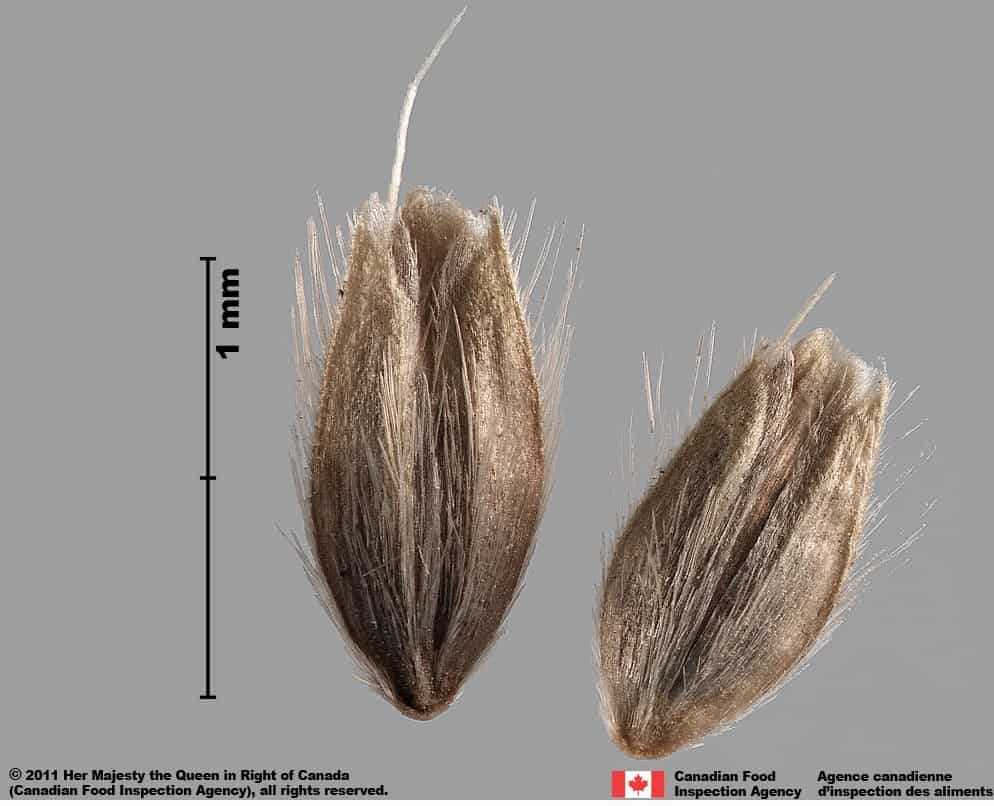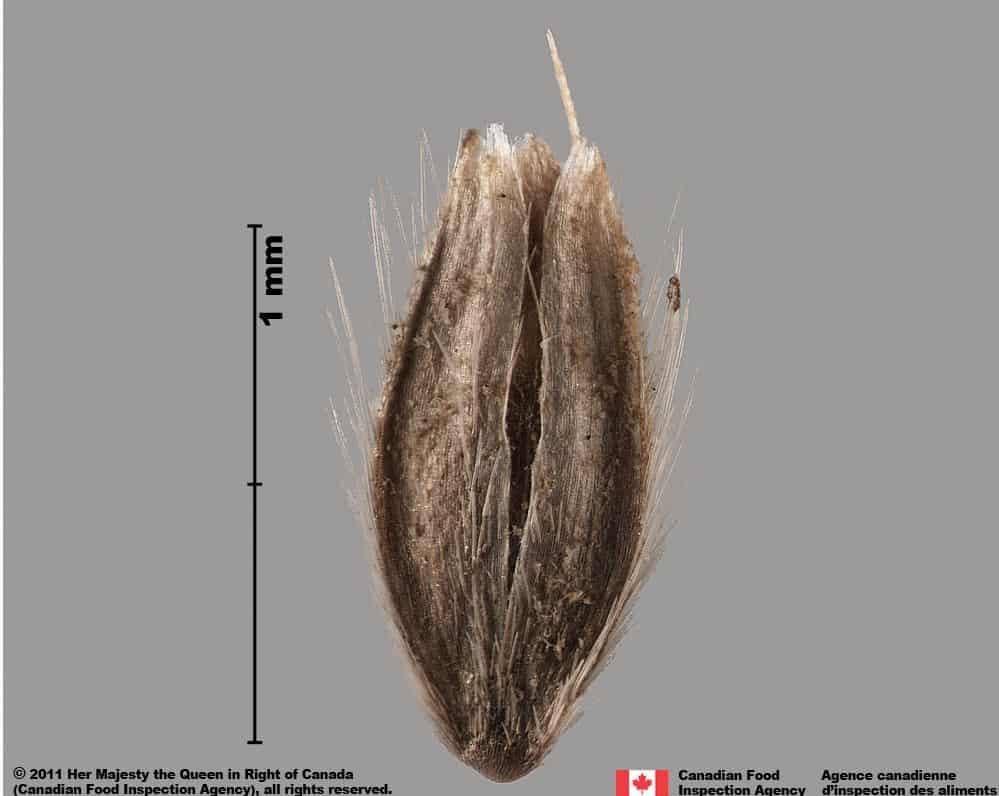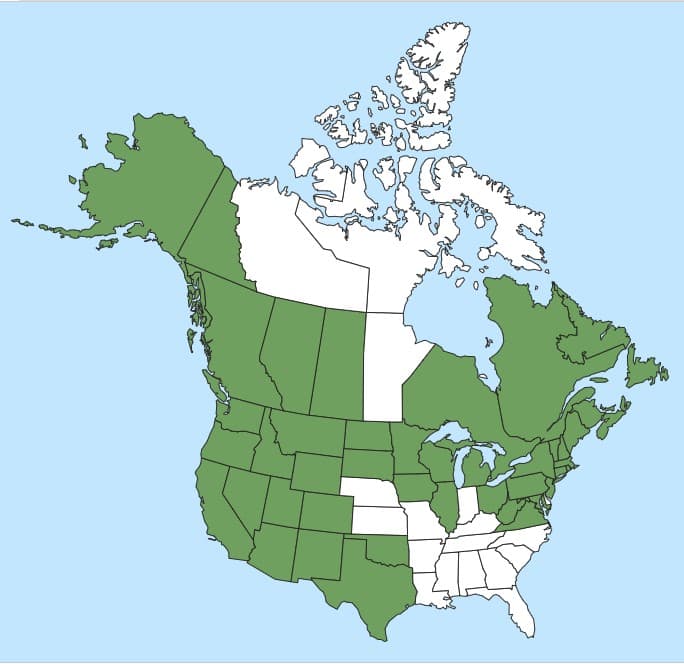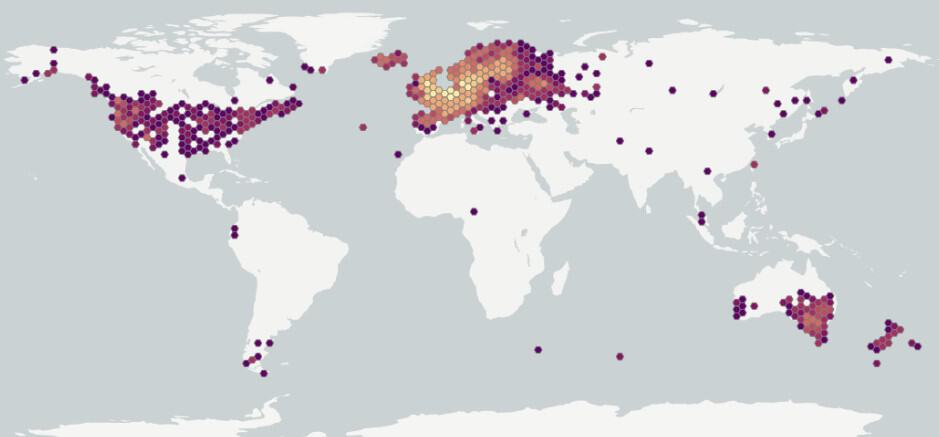Alopecurus geniculatus
Explore More :
Explore plus :
Overview
Aperçu
Regulation :
Remarques Réglementation:
Regulation Notes:
Distribution :
Répartition :
Native to Eurasia and western United States and Canada, naturalized in eastern Canada and eastern United States from Virginia northward (Barkworth et al. 2007; USDA-ARS 2021; WOA 2021). However, there is conflicting distribution information in the literature and although widespread in the US and Canada, other sources consulted have this species as not native to North America (NPT 2021; USDA-NRCS 2021).
Introduced in Australia with occurrences primarily in central South Australia, southern Queensland, New South Wales, Victoria and Tasmania. (Kodela et al. 2020)
Habitat and Crop Association :
Habitat et Cultures Associées :
Alopecurus geniculatus prefers moist clay, mud, silt or peat and full sun exposure (Cao et al. 2023). In North America, this species occurs in shallow water, marshes, ditches, damp meadows, shorelines, and streambanks from lowland to montane zones (Barkworth et al. 2007). The species is reported to occur in marshes and damp meadows in Europe (Tutin et al. 1980). In Australia it is found in damp lowland areas, in grasslands, eucalypt flats, swampy areas, vernal pools, inland lake shorelines, land subject to flooding and aquatic habitats; occasionally partly submerged. (Kodela et al. 2020; WOA 2021).
Although native to Europe, it is a weed of low-tillage crops in parts of Europe (NPT 2021). This species is generally classified as a weed seed when found in seed for planting in the United States and Canada (AOSA 2021).
Economic Use, cultivation area, and Weed Association :
Utilisation économique, zone de culture et association de mauvaises herbes :
Duration of Life Cycle :
Durée du cycle vital:
Perennial
Dispersal Unit Type :
Type d’unité de dispersion :
Spikelet (single floret spikelet)
General Information
RENSEIGNEMENTS GÉNÉRAUX
Alopecurus geniculatus is a tufted perennial grass, well adapted to moist or wet soils, especially wet clay, mud, silt, or peat, and is not tolerant to drought (Cao et al. 2023). It reproduces by seeds as well as vegetatively by rooting at lower stem nodes (Barkworth et al. 2007; Cao et al. 2023) forming new plants at the nodes; however, the number of seeds produced per plant is not known.
Alopecurus geniculatus is known to hybridize with other species of Alopecurus, including A. aequalis Sobol., A. bulbosus Gouan , and A. pratensis L.
Alopecurus ×haussknechtianus Asch. & Graebn. is a sterile hybrid of A. geniculatus and A. aequalis reported to occur in areas where the two parent species overlap in distribution particularly in the middle portion of North America from Alberta and Saskatchewan in the north to Arizona and New Mexico in the south (Barkworth et al. 2007).
Alopecurus ×plettkei Mattfeld, the sterile hybrid between A. geniculatus and A. bulbosus, is known from Belgium, Germany, the Netherlands, and Great Britian (Trist and Wilkinson 1988).
Alopecurus ×brachystylus is a reported hybrid between A. geniculatus and A. pratensis (Cao et al. 2023). The hybrid is reported as native to Austria, Baltic States, Belgium, Czech Republic, Denmark, Finland, France, Germany, Great Britain, Hungary, Netherlands, Norway, Poland, Sweden, West Siberia (Kew Science 2022).
.Identification
Identification
-
Spikelet
Size
- Spikelet length: 2.3 – 3.4 mm (average 3.1mm) (D. Meyer*)
- Spikelet width: 0.9 – 1.9 mm (average 1.1 mm) (D. Meyer*)
*Note: minimum and maximum based on combined 5 samples with a random selection of 64 spikelets in a normal range of this species using image measurement protocol (ISMA 2020)
Additional size information from literature:
- Spikelet length: 2 – 3.5 mm (Tutin et al. 1980)
- Spikelet length: 1.9 – 3.5 mm (Barkworth et al. 2007)
- Spikelet length: 2.5 – 3 mm (Baldwin et al. 2012)
- Spikelet length: (2–) 2.2–3.5 mm long (Kodela et al. 2020)
Shape
- Spikelet shape is oval to egg-shaped; laterally compressed.
Surface Texture
- Spikelet glumes thin and membranous, covered with long silky hairs.
Colour
- Spikelet is pale straw yellow to grayish brown coloured, sometimes purplish.
Other Features
Glumes
- Glumes two, completely enclosing the single floret (excluding the awn), margins fuse near base.
- Tips of glumes parallel such that the tip of the floret is sometimes visible, strongly keeled, not winged.
- Each glume has three longitudinal nerves, one dorsal along the keel and two laterals (appearing as faint lines).
- Hairs along the entire keel (from base to tip of glume) are long and flexible (ciliate).
Spikelet callus (spikelet attachment scar)
- Spikelet callus is an inconspicuous narrow rolled ridge turned towards one side of the spikelet.
- The point of attachment of the spikelet is an inconspicuous point above the center of the callus ridge.
Other features
- Disarticulation of the dispersal unit, spikelet, occurs below the glumes.
- Each spikelet has a single floret.

Water foxtail (Alopecurus geniculatus) spikelets


-
Floret
Size
- Lemma length: 2.5 – 3.0 mm (Tutin et al. 1980; Barkworth et al. 2007).
- Lemma length: 2.0 – 3.0 (3.5) mm (Kodela et al. 2020).
Shape
- Floret is narrowly egg-shaped, laterally compressed.
Surface Texture
- Floret texture is smooth with a few scattered hairs.
Colour
- Floret is yellow to light grayish brown coloured.
Other Features
Lemma
- Lemma is thin and membranous.
- The lemma margins are fused together in lower one-third to one-half.
Lemma awn
- Lemma awn attached slightly above base to near mid-point of lemma, extending out beyond the tip of the glumes by 1.1 – 3.3 mm, average 2.0 mm (D. Meyer*).
- Bend in awn located near the tips of the glumes.
*Note: minimum and maximum based on combined 5 samples with a random selection of 53 spikelets in a normal range of this species using image measurement protocol (ISMA 2020)
Additional size information from literature:
- Lemma awn: 3 – 5 (6) mm long (Barkworth et al. 2007).
- Lemma awn: 3 – 6.5 (7.7) mm long (Kodela et al. 2020).
Palea
- Palea is absent
-
Caryopsis
Size
- Caryopsis length: 1.7mm; width: 0.8 – 1.0 mm, average 0.9 mm (D. Meyer*).
*Note: minimum and maximum based on combined 2 caryopses in a normal range of this species using image measurement protocol (ISMA 2020).
Additional size information from literature:
- Caryopsis length: 1 – 1.5 mm (Barkworth et al. 2007).
Shape
- Caryopsis D-shaped, laterally compressed.
Surface Texture
- Caryopsis texture smooth or granular.
Colour
- Caryopsis greenish brown to brown coloured.
Other Features
Hilum
- Hilum shape oval, near base of caryopsis.
Style bases
- Style bases fused together and sometimes visible on free caryopsis as a pointed appendage on the apex of the caryopsis.
-
Embryo
Size
- Embryo one-quarter to one-third the length of the caryopsis.
Shape
- Embryo is oval shaped.
Endosperm
- Endosperm is semi-liquid and translucent yellowish coloured.
Other Features
- Embryo is located along the (dorsal) edge of the caryopsis.
Identification Tips
CONSEILS POUR L’IDENTIFICATION
Dispersal units of Alopecurus geniculatus are similar those of A. aequalis and A. carolinianus. Spikelets of these three species are similar in size, but the main diagnostic character is the lemma awn. In A. geniculatus and A. carolinianus the awn extends more than 1 mm beyond the tips of the glumes and is bent; the awn bend in A. geniculatus is near the tips of the glumes and in A. carolinianus the bend is well above the tips of the glumes. In A. aequalis the awn is straight and extends less than 1 mm beyond the tips of the glumes. For details, see the comparison of these three species under section the similar species section.

Water foxtail (Alopecurus geniculatus) spikelet


Additional Botany Information
AUTRES RENSEIGNEMENTS BOTANIQUES
Flowers/Inflorescence
- Lodicules absent (Naylor 1972; Barkworth et al. 2007).
- Anthers (0.9) 1.4 – 2.2 mm, yellow (Barkworth et al. 2007); brown at maturity (Tutin et al. 1980); 0.7 – 1.8 mm (Kodela et al. 2020).
- Each plant can produce one to several spike-like panicle inflorescences.
- Panicles 1.5 – 7 cm long and 4 – 8 mm wide (Barkworth et al. 2007).
Vegetative Features
- Plants forming dense tufts, stems up to 60 cm long, erect or lying flat and rooting at the lower nodes (Barkworth et al. 2007).
Similar Species
ESPÈCES SEMBLABLES
Similar species are based on a study of seed morphology of various species, and those with similar dispersal units are identified. The study is limited by physical specimen and literature availability at the time of examination, and possibly impacted by the subjectivity of the authors based on their knowledge and experience. Providing similar species information for seed identification is to make users aware of similarities that could possibly result in misidentification.
Alopecurus aequalis Sobol.
Shortawn foxtail (English) (Barkworth et al. 2007; AOSA 2021)
Vulpin à courtes arêtes (French) (Barkworth et al. 2007)
Perennial, native to temperate areas of the Northern Hemisphere and naturalized in parts of Central and South America, Australia, and New Zealand (USDA-ARS 2021); spikelet length 2.1 – 2.7 mm, average 2.4 mm (D. Meyer*); spikelet width 0.8 – 1.1 mm, average 1.0 mm (D. Meyer*); glumes membranous, pale green in colour, occasionally purplish, sparsely long pubescent on sides, keels ciliate; lemma awn exceeding glumes by 0.3 – 0.8 mm, average 0.5 mm (D. Meyer*), straight and delicate; caryopsis 1 – 1.8 mm long (Barkworth et al. 2007); anthers 0.5 – 1.2 mm long, pale to deep yellow or orange, rarely purple (Barkworth et al. 2007).
*Note: minimum and maximum based 20 spikelets in a normal range of this species using image measurement protocol (ISMA 2020); CDA-S-21558.
Additional size information from literature:
Alopecurus aequalis: perennial; glumes 1.8 – 3.7 mm long; awns straight, not exceeding lemmas or exceeding them by less than 2.5 mm (Barkworth et al. 2007).
Alopecurus carolinianus Walter
Carolina foxtail (AOSA 2021; USDA-NRCS 2021)
Tufted foxtail (Barkworth et al. 2007)
Annual; native to western Canada and throughout the United States except the northeastern states (Cronquist et al. 1977; USDA-NRCS 2021); spikelet length 2.4 – 2.8 mm, average 2.7 mm (D. Meyer**); spikelet width 0.9 – 1.1 mm, average 1.0 mm (D. Meyer**); glumes membranous, pale green to pale yellow in colour, sparsely long pubescent on sides, keels ciliate; lemma awn exceeding glumes by 1.6 – 3.1 mm, average 2.5 mm (D. Meyer**), bend in awn located well above the tips of the glumes; caryopsis 1 – 1.5 mm long (Barkworth et al. 2007); anthers 0.3 – 1 mm, yellow or orange (Barkworth et al. 2007).
**Note: minimum and maximum based 10 spikelets in a normal range of this species using image measurement protocol (ISMA 2020); CDA-S-21578.
Additional size information from literature:
Alopecurus carolinianus: glumes 2.1 – 3.1 mm long; lemma awn geniculate, exceeding lemmas by 1.6 – 4 mm (Barkworth et al. 2007).
Comparison of similar species (based on D. Meyer measurements)
| Alopecurus geniculatus | Alopecurus aequalis | Alopecurus carolinianus | |
| Spikelet length | 2.3 – 3.4 mm | 2.1 – 2.7 mm | 2.4 – 2.8 mm |
| Spikelet width | 0.9 – 1.9 mm | 0.8 – 1.1 mm | 0.9 – 1.1 mm |
| Awn extension beyond glume tips | 1.1 – 3.3 mm | 0.3 – 0.8 mm | 1.6 – 3.1 mm |
| Awn bend location | Near tips of glumes | No bend | Well above tips of glumes |
Click to select species
Cliquez pour sélectionner les espèces
Comparison Window
Fenêtre de comparaison
MAIN SPECIES
ESPÈCES PRINCIPALES
Alopecurus geniculatus

Alopecurus geniculatus
Poaceae
Water foxtail (Alopecurus geniculatus) spikelets
MAIN SPECIES
ESPÈCES PRINCIPALES
Alopecurus geniculatus

Alopecurus geniculatus
Poaceae
Water foxtail (Alopecurus geniculatus) spikelet
Need ID Help?
Besoin d’aide pour l’identification?
Reference(s)
Référence(s)
Association of Official Seed Analysts (AOSA). 2021. AOSA Rules For Testing Seeds. Volume 3: Uniform Classification of Weed and Crop Seeds. Association of Official Seed Analysts, Washington D. C.
Baldwin B. G, Goldman, D., Keil, D. J., Patterson, R., Rosatti, T. J., Wilken, D. (Eds.). 2012. The Jepson Manual : Vascular Plants of California. 2nd Ed. University of California Press, Berkeley, CA.
Barkworth, M. E., Capels, K. M., Long, S. and Piep, M. B. (Eds.). 2007. Flora of North America Volume 24. Magnoliophyta: Commelinidae (in part): Poaceae, part 1. Oxford University Press, New York, New York.
Cao, L., J. Larson, L. Berent, A. Fusaro, and S. Iott, 2023, Alopecurus geniculatus L.: U.S. Geological Survey, Nonindigenous Aquatic Species Database, Gainesville, FL, https://nas.er.usgs.gov/queries/factsheet.aspx?SpeciesID=2681, Revision Date: 3/9/2022, Access June 28, 2023.
Cronquist, A., Holmgren, A. H., Holmgren, N. H., Reveal, J. L., Holmgren, P. K. 1977. Intermountain Flora: Vascular Plants of the Intermountain West, U.S.A. The New York Botanical Garden, Columbia University Press, New York, N.Y.
International Seed Morphology Association (ISMA). 2020. Method for Seed Size Measurement. Version 1.0. ISMA Publication Guide. https://www.idseed.org/authors/details/method_for_seed_size_measurement.html
Kodela, P.G., Weiller, C.M., and Thompson, I.R. 2020. Alopecurus geniculatus, in Kodela, P.G. (Ed.), Flora of Australia. Australian Biological Resources Study, Department of Agriculture, Water and the Environment: Canberra. https://profiles.ala.org.au/opus/foa/profile/Alopecurus%20geniculatus Accessed November 18, 2021.
NPT (Native Plant Trust). 2021. Go Botany. https://gobotany.nativeplanttrust.org/species/alopecurus/geniculatus/ Accessed December 6, 2021.
Trist, P. J. O. and Wilkinson, M. J. 1988. Alopecurus x plettkei Mattfeld in Britain. Watsonia 17:301-308.
Tutin, T. G., Heywood, V. H., Burges, N. A., Moore, D.M., Valentine, D. H., Walters, S. M., Webb, D. A. (Eds.). 1980. Flora Europaea. Volume 5 Alismataceae to Orchidaceae (Monocotyledones). Cambridge University Press.
U.S. Department of Agriculture-Agricultural Research Services (USDA-ARS). 2021. Germplasm Resources Information Network (GRIN), https://npgsweb.ars-grin.gov/gringlobal/taxon/taxonomydetail?id=2645. Accessed November 17, 2021.
U.S. Department of Agriculture-Natural Resources Conservation Service (USDA-NRCS). 2021. The PLANTS Database. National Plant Data Team, Greensboro, NC USA. http://plants.usda.gov Accessed December 5, 2021.
WOA (Weeds of Australia). 2021. https://keyserver.lucidcentral.org/weeds/data/media/Html/alopecurus_geniculatus.htm Accessed December 6, 2021]
Wiersema, J. H. and León, B. 1999. World Economic Plants : A Standard Reference. CRC Press, Boca Raton, FL.
Kew Science. 2022. Alopecurus ×brachystylus Peterm. Plants of the World Online. https://powo.science.kew.org/taxon/urn:lsid:ipni.org:names:387041-1 Accessed April 5, 2022.




